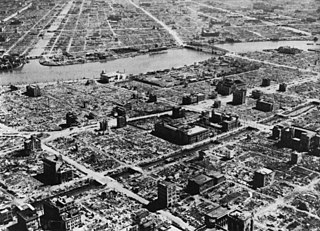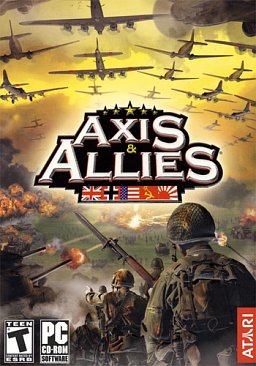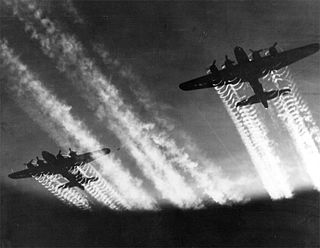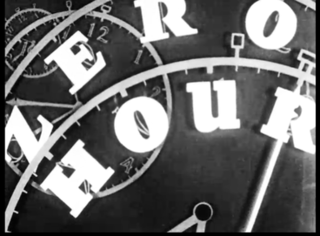External links
- The Fight for the Sky on YouTube
- The Fight for the Sky at IMDb
- The short film The Fight For The Sky is available for free viewing and download at the Internet Archive .
| The Fight for the Sky | |
|---|---|
| Produced by | Office of War Information |
| Starring | Jimmy Doolittle |
| Narrated by | Ronald Reagan, Reed Hadley |
Release date |
|
Running time | 20 minutes (theatrical release) 41 minutes (original) |
| Country | United States |
| Language | English |
The Fight for the Sky is a short propaganda film commissioned by the US government to highlight the victories of the Allied air forces over Europe prior to the Normandy invasion.
Opening with shots of aerial combat over Europe the film turns to footage of the airmen acting casually in their base in East Anglia, reading newspapers, playing ping pong, and listening to the radio. However, they are soon called for a debriefing about their next mission, a strike deep into Germany's industrial region, the Ruhr. They ready their planes and arrive over their targets like clockwork, shooting down some German Luftwaffe planes in the process. None of the missions have failed due to enemy resistance alone, the narrator informs the audience, though some have not succeeded because of weather conditions. Captured German footage is shown to prove that the enemy was just as determined to stop the attacks as the Allies were to carry them out.
In February 1944 a new bombing initiative is begun. Instead of waiting to be attacked by the Germans the Americans will seek them out, targeting German airfields. Then the focus turns to enemy transportation, and the Allies make it impossible for a railroad to operate at day, also targeting trucks, barges, and even flak towers. All this made the eventual landings at Normandy and the opening of the second western front possible. With victory won in Europe, it must now be won in the Pacific.
Two versions of the film were released. A short version, narrated by Ronald Reagan, was released to theatres with a running time of approximately 20 minutes. The complete version, with narration by Reed Hadley, runs 41 minutes.

Why We Fight is a series of seven propaganda films produced by the US Department of War from 1942 to 1945, during World War II. It was originally written for American soldiers to help them understand why the United States was involved in the war, but US President Franklin Roosevelt ordered distribution for public viewing.

Strategic bombing is a military strategy used in total war with the goal of defeating the enemy by destroying its morale, its economic ability to produce and transport materiel to the theatres of military operations, or both. It is a systematically organized and executed attack from the air which can utilize strategic bombers, long- or medium-range missiles, or nuclear-armed fighter-bomber aircraft to attack targets deemed vital to the enemy's war-making capability. The term terror bombing is used to describe the strategic bombing of civilian targets without military value, in the hope of damaging an enemy's morale.

Operation Dragoon was the code name for the landing operation of the Allied invasion of Provence on 15 August 1944. Although initially designed to be executed in conjunction with Operation Overlord, the Allied landing in Normandy, a lack of available resources led to a cancellation of the second landing. By July 1944 the landing was reconsidered, as the clogged-up ports in Normandy did not have the capacity to adequately supply the Allied forces. Concurrently, the High Command of the French Liberation Army pushed for a revival of the operation that would include large numbers of French troops. As a result, the operation was finally approved in July to be executed in August.

The Normandy landings were the landing operations and associated airborne operations on Tuesday, 6 June 1944 of the Allied invasion of Normandy in Operation Overlord during World War II. Codenamed Operation Neptune and often referred to as D-Day, it was, and still is, the largest seaborne invasion in history. The operation began the liberation of France and laid the foundations of the Allied victory on the Western Front.
Big Week or Operation Argument was a sequence of raids by the United States Army Air Forces and RAF Bomber Command from 20 to 25 February 1944, as part of the European strategic bombing campaign against Nazi Germany. The planners intended to attack the German aircraft industry to lure the Luftwaffe into a decisive battle where the Luftwaffe could be damaged so badly that the Allies would achieve air superiority which would ensure success of the invasion of continental Europe.

Axis & Allies is a real-time strategy World War II video game developed by TimeGate Studios and published by Atari for Microsoft Windows. The game was released on November 2, 2004. It is based on the board game series Axis & Allies from Milton Bradley and also on TimeGate's Kohan series. Set in the years after Japan and the United States entered into the war, the game allows the player to act as a World War II commander to build military forces to fight against other generals, using military units and technologies from the war. The player is able to rewrite and recreate the history of World War II.

USS Hobson (DD-464/DMS-26), a Gleaves-class destroyer, was the only ship of the United States Navy to be named for Richmond Pearson Hobson, who was awarded the Medal of Honor for actions during the Spanish–American War. He would later in his career attain the rank of rear admiral and go on to serve as a congressman from the state of Alabama.
Blazing Angels: Squadrons of WWII is a flight combat video game for Microsoft Windows, Xbox, Xbox 360, PlayStation 3 and Wii. It was developed by Ubisoft Bucharest during the second fiscal quarter of 2006 for both the North American and European regions. The game features 46 different World War II fighter planes and allows the player or players to take part in several World War II events as a fictional squadron. Online support allows 16 players to take part in head-to-head and co-operative battles.

The military history of the United States during World War II covers the nation's role as one of the major Allies in their victory over the Axis Powers. The United States is generally considered to have entered the conflict with the 7 December 1941 surprise attack on Pearl Harbor by the Empire of Japan and exited it with the 2 September 1945 surrender of Japan. During the first two years of World War II, the US maintained formal neutrality, which was officially announced in the Quarantine Speech delivered by US President Franklin D. Roosevelt in 1937. While officially neutral, the US supplied Britain, the Soviet Union, and China with war materiel through the Lend-Lease Act signed into law on 11 March 1941, and deployed the US military to replace the British forces stationed in Iceland. Following the 4 September 1941 Greer incident involving a German submarine, Roosevelt publicly confirmed a "shoot on sight" order on 11 September, effectively declaring naval war on Germany and Italy in the Battle of the Atlantic. In the Pacific Theater, there was unofficial early US combat activity such as the Flying Tigers.

December 7th is a 1943 propaganda documentary film produced by the US Navy and directed by John Ford and Gregg Toland, about the December 7, 1941 attack on Pearl Harbor, the event which sparked the Pacific War and American involvement in World War II. Toland was also the film's cinematographer. The original version of this film, with a running time of 82 minutes, was not released but was retained by the National Archives. An edited version of 32 minutes length, which removed a long introductory segment and a shorter epilogue, was given limited release to specific audiences but won the Academy Award for Best Documentary in 1944. This is the only film Toland ever worked on for which he received a director credit.

Britain re-created the World War I Ministry of Information for the duration of World War II to generate propaganda to influence the population towards support for the war effort. A wide range of media was employed aimed at local and overseas audiences. Traditional forms such as newspapers and posters were joined by new media including cinema (film), newsreels and radio. A wide range of themes were addressed, fostering hostility to the enemy, support for allies, and specific pro war projects such as conserving metal and growing vegetables.
Two Down and One to Go was a short propaganda film produced in 1945 directed by Frank Capra; as its title might suggest, its overall message was that the first two Axis powers, Italy and Germany, had been defeated, but that one, Japan, still had to be dealt with.

The 373rd Fighter Group is an inactive United States Army Air Force unit. Its last assignment was with First Air Force stationed at Mitchel Field, New York. It was inactivated on 7 November 1945.

Air warfare was a major component in all theaters of World War II and, together with anti-aircraft warfare, consumed a large fraction of the industrial output of the major powers. Germany and Japan depended on air forces that were closely integrated with land and naval forces; the Axis powers downplayed the advantage of fleets of strategic bombers and were late in appreciating the need to defend against Allied strategic bombing. By contrast, Britain and the United States took an approach that greatly emphasized strategic bombing and tactical control of the battlefield by air as well as adequate air defenses. Both Britain and the U.S. built substantially larger strategic forces of large, long-range bombers. Simultaneously, they built tactical air forces that could win air superiority over the battlefields, thereby giving vital assistance to ground troops. The U.S. Navy and Royal Navy also built a powerful naval-air component based on aircraft carriers, as did the Imperial Japanese Navy; these played the central role in the war at sea.

The bombardment of Cherbourg took place on June 25, 1944, during World War II, when ships from the United States Navy and the British Royal Navy attacked German fortifications in and near the city, firing in support of U.S. Army units that were engaged in the Battle of Cherbourg. In doing so, the Allied naval forces engaged in a series of duels with coastal batteries and provided close support to infantry as they fought to gain control of the city. The bombardment was initially scheduled to last just two hours but it was later extended by an hour to support army units attempting to break into Cherbourg's city streets. After the bombardment, German resistance lasted until June 29, when the port was captured by the Allies. Afterwards, the task of clearing the port for use lasted several weeks.

Operation Gisela was the codename for a German military operation of the Second World War. Gisela was designed as an aerial intruder operation to support the German air defence system in its night battles with RAF Bomber Command during the Defence of the Reich campaign. It was the last major operation launched by the Luftwaffe Nachtjagdgeschwader during the conflict.

Break-through is an 11-minute 1944 Canadian documentary film, made by the National Film Board of Canada (NFB) as part of the wartime Canada Carries On series. The film documents the attack on Fortress Europe during the Second World War and the advance of Allied forces to the borders of Nazi Germany. Break-through was produced by James Beveridge. The film's French version title is L'assaut.

Road to the Reich is a 10-minute 1945 Canadian documentary film, directed and produced by Tom Daly for the National Film Board of Canada as part of the wartime Canada Carries On series. The film documents the Allied forces advances, after the Normandy landings, through France and Belgium during the Second World War. The French version of Road to the Reich is Aux portes du Reich.

Zero Hour is a 22-minute 1944 Canadian documentary film, made by the National Film Board of Canada (NFB) as part of both the wartime Canada Carries On and The World in Action series. The film was produced by Stuart Legg. Zero Hour describes the Axis and Allied invasions that have taken place during the Second World War.

The bombing of Nijmegen on 22 February 1944 was an opportunistic aerial bombing raid by the United States Army Air Forces on the city of Nijmegen in the Netherlands, then occupied by Nazi Germany. In terms of the number of victims, it was one of the largest bombardments of a Dutch city during World War II. Officially, nearly 800 people were killed by accident due to inaccurate bombing but, because people in hiding could not be counted, the actual death toll was probably higher. A large part of the historic city centre was destroyed, including Saint Steven's Church. Saint Augustine's Church and Nijmegen railway station were heavily damaged as well.